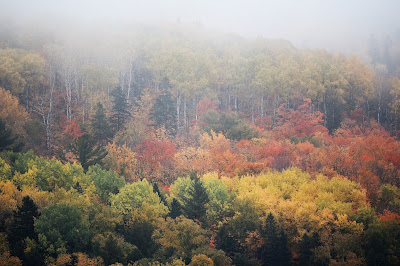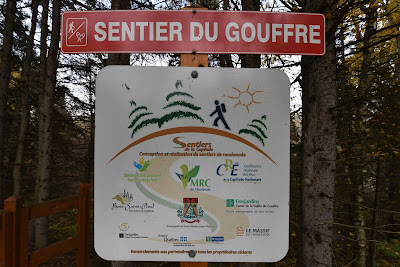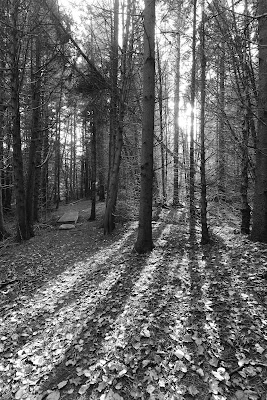There is always Sacrifice, there is always Wonder : Baie-Saint-Paul
After a very short night with little sleep, we got up early, enjoyed a delicious breakfast of coffee and omelettes at the hotel, and then walked back to the train/bus station. It was a warm, overcast morning, and the narrow, winding streets of Quebec City were full of people making their way to work. A particular highlight was passing the Église Saint-Roch, which was constructed between 1914 and 1923 and is the largest church in Quebec City. Saint Roch is a Catholic Saint who is invoked against plague and epidemics and has gained veneration during the Covid 19 pandemic, but we have a soft spot for him, as he is also the patron saint of pilgrims. Outside the imposing stone building, with its rose windows and double steeples was a shelter with several refrigerators where people left food for the homeless who gathered on the cathedral steps.
By late morning we boarded an Intercar bus headed not for the Charlevoix hills as we had hoped for but for the beautiful and historic town of Baie-Saint-Paul, where we will pick up the Trans Canada Trail again to begin walking west. For those who followed us in 2019, you might recall that we stopped in Rivière-du-Loup, which is about 143 km of trail east of Baie-Saint-Paul. From Rivière-du-Loup the trail heads into La Traversée de Charlevoix, which requires reservations to hike across. Apparently it is only possible to hike this section west to east, and since the fall colours are still at their height, we weren't able to organize the necessary permits in time. Our plan – at the moment - is to return to La Traversée Charlevoix during the winter, to complete the trail on snowshoes, giving us another way to experience Quebec and this iconic region.
As the bus headed east along the highway, following the shores of the St. Lawrence Seaway, we got a preview of the coming attractions. The forested hills that rose on all sides of us were blanketed in red, orange, and yellow foliage which glowed with an intensity that set the foggy and overcast day on fire. It was stunningly beautiful, but as the bus climbed, and climbed, and climbed – and as the engines of cars around us whined as they pulled - up through a dense fog and then up into the clouds, we couldn't help being daunted by what lies ahead of us during the next five days. We may have just walked 2,500 km across the prairies, but the flat roads and the push carts have done nothing to prepare us for carrying our fully loaded packs over the Laurentian Mountains!
The bus took us through many small communities scattered along the shores of the Saint Lawrence Seaway. We passed the huge and very impressive Montmorency Falls, which we will hike past in a few days, and the Cathedral in Mont Saint Anne. As we began to climb into the hills, and much of the landscape was swallowed by the thick mist and clouds, we passed small farms and rural communities which looked very European, and had an intriguing air of mystery in the fog. Behind the small white homes and buildings the forested peaks rose in the background, in a blaze of yellows and greens.
The final descent into Baie-Saint-Paul on the highway had a 20% grade, which was so steep the bus had to pull over to check its brakes before heading down the slope. Our ears popped from the elevation change, making us wish we could start our hike from the top of the hill, rather than the bottom!
We walked to our motel and were very grateful to the kind owner who let us leave our heavy packs in a safe spot until we could check in later in the afternoon. After depositing our backpacks we walked the few kilometres into downtown Baie-Saint-Paul on a lovely paved bike path that followed a babbling stream through a forested corridor. It felt so good to be surrounded by lush green trees again, to hear flowing water, and to smell the fresh scent of wet leaves and wood smoke in the air. The pathway felt like such a luxury after the dusty roads of the prairies that we walked very slowly, taking lots of photos and trying to savour every moment.
When we reached the town we walked down a charming, winding main street lined with small restaurants and bistros, artisan shops, and art galleries. Many of the two story brick, stone, and white panelled shops had colourful balconies that were covered with vibrant red vines and colourful fall displays. The smell of baking bread, fresh ground coffee, smoked meat, and savoury cooking floated down the sidewalk, which was full of tourists and locals enjoying the culture, art, and colours of the region.
Here while sitting, enjoying warm pastries and hot chocolates on a store veranda we scrolled through images of Alberta’s night sky and the present amazing displays of the northern lights above the prairies right now. In so many ways it is heartbreaking to have missed out on the living skies and northern lights being experienced – but as we looked around at our present surroundings the fall colours of Charlevoix are a worth exchange. With that said however, there is no doubt that for every decision we make out here, with each turn in the road, each choice to push on or stay a night in a certain location invariably there is a sacrifice of one set of experiences for another.
Black marble monuments to local artists were also tucked into brick courtyards and alleyways along the winding streets, together with samples of their work. One example was Alexander Jackson Young, who was born in Montreal in 1882. After training at l'Academie Julian in Chicago and Paris he shared a workshop with Tom Thompson in Toronto, and then went on to found the famous Group of Seven in 1920. In 1923, Jackson joined Gagnon, Hutchinson, Boyd, Holgate, Lismer, and other well-known artists in Baie-Saint-Paul.
The snowy landscapes in this area that he visited on snowshoes became the inspiration for many of his paintings, and he was known locally as 'Père Raquette' or 'Father Snowshoes.' Many artists have been attracted by the stunning landscapes of this region, and today Baie-Saint-Paul apparently has one of highest densities of art galleries and craft boutiques anywhere in Canada.
We stepped into a small café for a tiny cup of espresso whose strength and full flavor we've enjoyed in many gîtes while hiking the GR 65 in France. Thus fortified, we made our way to the end of main street and continued down a quiet, well-landscaped street, through a residential neighbourhood to the marina. The sidewalk took us to a footpath that ran along the shore of the Gouffre River as it made its way out to the Saint Lawrence Seaway.
The steep hills rose on either side of the wide river delta, whose sand bars and grassy marshes were partially exposed by the low tide.
Baie-Saint-Paul was established at the mouth of the Gouffre River in 1678 as part of New France. It remained largely isolated by the steep hills and cliffs that surrounded it until 1812, when a road connecting it to Quebec City was built. It gained notoriety in the 1770s when Dr. Phillipe-Louis-Francois Badelard named a local ailment he was researching the 'Baie-Saint-Paul maladie.' The sickness turned out to be a strain of venereal disease, and his conclusions became one of the first medical studies published in Canada. Another claim to fame of this small town is that the Cirque du Soleil was founded here in 1984 by the former street performers, Guy Laliberté and Gilles Ste-Croix.
Past the small park and marina we walked out onto a short concrete pier which had works from local artists displayed along its length, and interpretive signage on the railing at the end. We had a stunning view out beyond the steep forested hills of the delta to the open waters of the Saint Lawrence and the rolling hills on the far side. Dark, low-hanging clouds swallowed the peaks of the colourful hills, but a band of pale yellow sunshine separated them from the ruffled grey waters below. The tangy smell of salt water mixed with the earthy aroma of leaves as we enjoyed the view on the warm autumn afternoon.
The Parc Boise du Quai is a great spot for birding as well. We spotted Great Blue Herons fishing along the edges of the river delta, as well as flocks of Great Black-backed Gulls, Ring-billed Gulls, and Double-crested Cormorants on the sand bars. Turkey Vultures soared overhead, following the updraft along the ridges, and the raucous calls of American Crows filled the air. Over 140 species of birds have been reported on eBird from this spot, which include an interesting mix of seabirds, raptors, and forest birds.
We made our way back along the river, and down the main street, stopping for a café mocha, which was made with actual melted chocolate - though sadly was served in a thimble sized cappuccino take out cup! We then continued on through another quiet neighbourhood to the beginning of the Sentier du Gouffre, which is part of the Trans Canada Trail. It is a moderate to easy 14 km trail that takes hikers and cyclists along the winding river, through a pastoral landscape, and up into the hills above the town, providing strikingly beautiful views of Baie-Saint-Paul below. We were delighted to see that it was marked not only with the Great Trail and Sentier National symbols, but also with the double red and white blazes used along the GR (Grande Rondonée) hiking routes in Europe.
As we left town we found ourselves on a very well-marked, wide, crushed stone trail that wove through a treed area along the river. Wooden benches and picnic tables were strategically placed along the trail to provide beautiful views of the winding waterway. Lots of people were out enjoying the colours, including a group of retired folks in electric wheelchairs. Small flocks of Black-capped Chickadees and Dark-eyed Juncos moved through the trees in chattering flocks, and we stopped to watch a Yellow-bellied Sapsucker foraging along the trunk of a nearby tree.
We made our way along, enjoying the sound of leaves crunching beneath feet and the smell of autumn in the air. Soon we climbed up into a more open area, crossing a field on a well-marked track. It was refreshing to see a group of other hikers crossing the pastoral landscape towards us, and to know that the farmer, who was out on his tractor would not be suspicious of two strange people in his field, but would know we were hiking the trail!
We crossed a busy, paved highway, skirted around a small farm, trekked across a little stream on a charming wooden footbridge, and then began climbing up a steep hill under cover of dense cedars. The soft, shaded, winding footpath switch backed up the hill. Bright yellow and red leaves carpeted the ground, large mossy eskers dotted the hillside, and beams of sunlight filtered through the conifers to the forest floor. The terrain and forest composition reminded us a little of some sections of Ontario's 900 km long Bruce Trail as well as pathways throughout Algonquin Park.
A few kilometres up the pathway we came to a pair of picnic tables that offered a stunning view back down the valley towards Baie-Saint-Paul. We stopped to enjoy the sight of rolling, sunlight hills blanketed in yellow, orange, and red disappearing into the distance. We could see the white buildings of the town below, and recognize the twin steeples of the cathedral. Beyond we could see the blue waters of the St Lawrence, and more hills receding into the blue distance. It was a very different kind of beauty from the browns, golden yellows, and faded greens of the open prairies we were walking in only one week ago.
Since it was getting late, we turned around and walked back to town in the warm, sunny afternoon. After checking into the motel we made a run to the grocery store to resupply for the next seven days. We haven't had to carry this much food since crossing the Top Sails in Newfoundland, and it is difficult to be enthusiastic about the prospect of carrying that much extra weight through these hills. It makes us appreciate the terrain of the prairies, which let us push the extra weight in the carts.
See you on the trail!
Remember to follow our entire adventure here : www.comewalkwithus.online
























































Comments
Post a Comment